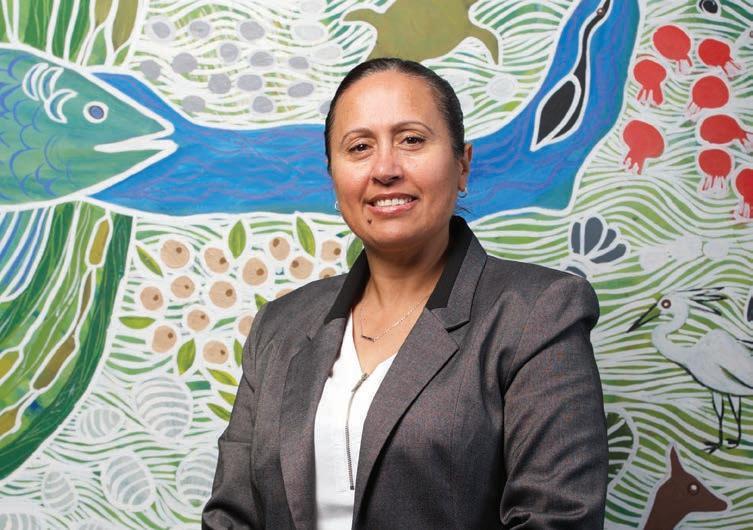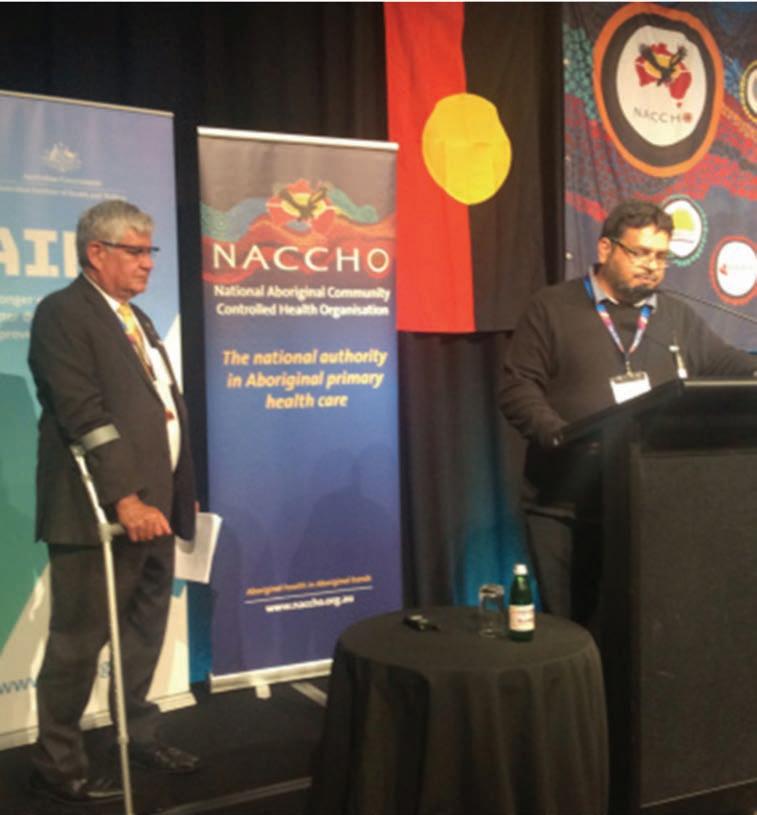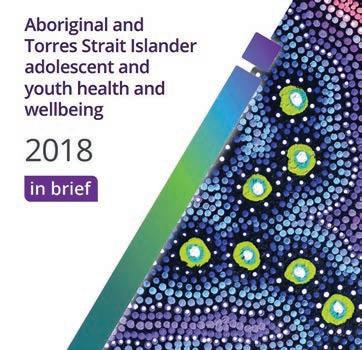
12 minute read
Aboriginal Children’s Commissioner starts work
Aboriginal families hold the key to transformation for children
April Lawrie (pictured) is passionate about having the strength of Aboriginal families and culture recognised. When she met with Aboriginal Way in a bustling café in Adelaide’s Central Markets recently, she shared a stream of ideas about ways to use the strength of families and culture to improve the lives of young people in her new role as Aboriginal Children’s Commissioner.
Advertisement
Her well-rounded experience, knowledge, and skills, with a lived experience provide crucial perspective on how the South Australian system is working for Aboriginal children. When she spoke to Aboriginal Way, Ms Lawrie had been only a few weeks at her office as South Australia’s first Aboriginal Children’s Commissioner, having commenced prior to the summer break on 3 December 2019.
Already she has a strong sense of what needs to be done over her three-year term, beginning with the importance of better support services for vulnerable families to prevent Aboriginal children being removed. She also emphasises the importance of the Aboriginal Child Placement Principle, meaning Aboriginal children who have been removed from their homes are placed with extended family or community or own kinship group. “Adhering to the Aboriginal Child Placement Principle, we know it’s the right way and it’s the best way, supporting Aboriginal children be safe and be identity and culture strong. “Because we know the legacy of the Stolen Generation and what that’s yielded for Aboriginal children and young people and for the entire Aboriginal population, the whole experience of intergenerational trauma. “We know that we need to remedy the past practices that have been detrimental to Aboriginal children and our future generations” she said. The way forward is in the hands of the Aboriginal community itself Ms Lawrie said.
“We have the solutions, we have maintained ourselves in our societies for thousands of years, and we know what’s required within our own families and our own communities to maintain children safely and with culture. “Aboriginal community controlled for child wellbeing is critical if we are to actually fulfil Aboriginal self-determination, when it comes to building a robust future for Aboriginal communities. “That means Aboriginal people taking the lead and Aboriginal people having greater say, involvement, participation, and implementation of the programs and services that affect the wellbeing of our Aboriginal children and young people” she told Aboriginal Way. The Commissioner for Aboriginal Children was appointed by the SA Government to influence change in policy, practice, and service delivery across health, welfare, education, and child protection and justice for the benefit of Aboriginal children, Ms Lawrie explained.
“That means getting joined-up services, ensuring that we’ve got collaboration between agencies and cooperation between services, particularly supporting our most vulnerable children and their families when it comes to the care, safety, and wellbeing of our children and young people. “It isn’t about duplicating anyone’s efforts, but truly bringing to the fore the advocacy that’s required based on the evidence that is there before us” she said.
Changing the approach that government systems take is crucial to the future of Aboriginal children and community members, Ms Lawrie said.
“They’re creating another society of Stolen Generation. The very things that we’ve highlighted in the national inquiry into the removal of Aboriginal children from their families has been replicated in the practices of continued removal at alarming rates and unprecedented levels of kids in non-Aboriginal care. That’s madness.”
The employment of Aboriginal people within the service system is one key to change, Ms Lawrie believes. However, it’s more than just a numbers game, those Aboriginal workers need to be in real positions of influence and in the right roles she said. “We criticise the system that remove our children but we have to be in there to change it and to stop it. “We know that there are Aboriginal employees across the various child focussed systems in the state, whether it’s education, child protection, youth justice or health. “But when you talk about the interface with child protection, more than likely at the front end of a child protection investigation, it’s a non-Aboriginal worker. Our whole service system in child protection is dominated by a very foreign culture of service delivery, which is more than often white and middle-class.
“There is a compelling argument to grow our Aboriginal workforce in social work services, so that we’re able to build culturally appropriate responses” Ms Lawrie said.
“but there is also getting the rest of the workforce, especially in the front line, to address their cultural bias and be culturally competent in effectively engaging Aboriginal children and their families.
The contribution of more Aboriginal families to providing care is key to overcoming the challenges facing Aboriginal children in the care system, this needs to be further teased out and supported Ms Lawrie told Aboriginal Way. “We know that if the child’s cultural identity and relationships is well developed, maintained and supported alongside the child’s safety and wellbeing, we begin to reduce the impact of intergenerational trauma” she said.
Recognising the stressors and pressures that are put on a child’s family is an important step Ms Lawrie believes, and is linked to understanding the need for early intervention. “The reality is that we have families needing extra support beyond that of universal services” Ms Lawrie said.
“There are a multitude of things that have happened that have impacted on families. All the things that determine your life outcome, we know we’ve got intergenerational trauma, we’ve got issues of family violence, as well as substance misuse impacting our Aboriginal communities and impacting on our families and the ability of people to care, provide for, and keep their children safe and well.
“We know all those things that are out there. There is the data, but there is also the stories and experiences of vulnerable Aboriginal children and young people and their families that need to be heard. “While there is a big emphasis on closing the gap, I firmly believe the focus should be on preventing the gap. “A focus on early intervention and prevention is therefore critical” she said. On considering how a single Commissioner can take on such large challenges, Ms Lawrie appears undaunted. “The focus on the first thousand days of life is absolutely critical to identifying the things in the system that are letting down our Aboriginal children. “So, there’s a lot of things happening, but at the same time we’re not getting the change in practice, nor the marked improvement that we desire, and we also know there are resources being injected into services, but are they going to the right places? Ms Lawrie is keen to collaborate with key stakeholders on research and promoting early intervention and prevention. “We need a call to action with what the data is saying and implement to make a difference, and I’m ensuring that I’ve got a very close working relationship with the Early Intervention Research Directorate, which is now placed within the Department of Human Services.
“I’ll also look to partner with key Aboriginal groups and advocates, such as the Aboriginal Community Leadership Reference Group who have done great advocacy, and the Aboriginal Family Health Research Group who have undertaken some fantastic research into the things that make a difference in better outcomes for families and Aboriginal children in the early years” she said.
Ms Lawrie will also focus on consultation with community members and bringing Aboriginal community perspectives in the reporting required by her role. “I’m required to report annually, that will be through the statutory role of the Commissioner for Children and Young People, based on the requirements of the Advocacy and Oversight Bodies Act” Ms Lawrie said.
Ms Lawrie is committed to getting on with the role in collaboration with that Commissioner, Ms Helen Connolly, as well as Mr Roger Thomas, the Aboriginal Engagement Commissioner. “I’ve got three years, and particularly the first 12 months is going to be crucial in not only defining priority areas to tackle, but also establishing the role, and really identifying where it’s best placed and developing the key working relationships.” “What I’m most focussed on is that examination of policy, practice and service delivery to work to improve outcomes for vulnerable Aboriginal children and young people, especially in early intervention and prevention, and from the voices of Aboriginal children and their families”.
A major report on Indigenous Youth Health across Australia has found that the majority of young people think that their own health is very good and feel an important connection to their traditional lands.
In contrast, unfair treatment and racism, mental health and experiences of violence are real challenges as they face the transition to adulthood often in an environment of inter-generational trauma and socioeconomic disadvantage
The Aboriginal and Torres Strait Islander Adolescent and Youth Health and Wellbeing 2018 report, released by the Australian Institute of Health and Welfare (AIHW) looks at 10-24 year olds and reveals specific information about their perceptions of their health as well as other health outcomes for the first time.
The report focusses on health and wellbeing outcomes, social determinants and risk factors and the use of health services by young Indigenous people across Australia, including in remote and non-remote areas.
Key findings include; the majority of young Indigenous people assessed their health as very good (63%), many young people felt a connection to their traditional lands and were involved in cultural events (69%), there has been an increase in young Indigenous people finishing year 12 or equivalent and there is a decrease in smoking among youth (31% smoke daily in 2015 from 45% in 2002).
Other key findings include the news that the mortality rate for young Indigenous people has declined, from 70 per 100,000 in 2005 to 67 per 100,000 in 2015.
In 2015, the leading causes of hospitalisations for young Indigenous people were injury and poisoning and mental and behavioural disorders. This contrasted to findings in 2011 which found self-inflicted injuries, traffic accidents and alcohol disorders as the leading causes of hospitalisation.
AIHW spokesperson, Dr Fadwa Al-Yaman noted that although young Indigenous Australians generally have good health based on a range of measures, not all are as healthy as they could be.
“Experiences of unfair treatment or racism, mental health, injuries and experiences of violence were areas of concern” she said.
In 2014/2015, about 1 in 3 (33%) young Indigenous Australians reported experiencing high to very high levels of psychological distress in the previous month. In 2011, the leading contributors to the disease burden for Indigenous 10 to 24-year-olds were suicide and self-inflicted injuries (13%) and anxiety disorders (8%).
Tobacco smoking, alcohol and substance use were also areas of concern. Despite an increase in the number of young people who never smoked – 44% in 2002 to 56% in 2014/2015, 3 in 10 were still daily smokers.
Although the death rate for young Indigenous Australians aged 10–24 has fallen over the last 10 years, around 490 (83%) of these deaths in 2011–2015 were classified as potentially avoidable, such as deaths from suicides, transport accidents and assault.
Dr Al-Yaman said that these challenges are complex, with social factors – such as education, employment and housing – playing an important role in health and wellbeing. John Singer NACCHO chair said the “snapshot-style report has been designed to provide an easy overview of the key issues, suitable for a wide audience”. Mr Singer said it is important to understand the health and everyday experiences of Indigenous youth. “Youth is a key transition period in a person’s life. It is a time when decisions

Minister for Indigenous Health Ken Wyatt launches the report. are made about relationships, education and career paths, employment and finances. The social, economic, environmental and technological changes that have occurred in recent decades mean that young people now face issues that previous generations may not have experienced. “Young Aboriginal and Torres Strait Islander people may face additional obstacles in making a successful transition to adulthood. The effect of inter-generational trauma, racism and prejudice, and socioeconomic disadvantage are all relevant in understanding the experiences of young Indigenous people today” he said. The report also raises some of the challenges faced by young First Australians including 42 per cent who were not engaged in education, employment or training. Although there has been a decline in smoking rates for young First Australians, one in three people aged between 15–24 was still a daily smoker in 2014/2015 and many faced long term heath challenges such as respiratory or vision problems, and mental health conditions.

Health Minister Ken Wyatt said the report gives insight into youth health for Closing the Gap. “It will inform the Closing the Gap refresh and help us to understand what is working well and where we need to focus our energies, so all young First Australians can reap the benefits of better health and wellbeing” said Minister Wyatt.
First Indigenous ORIC Registrar appointed
Gunggari man Selwyn Button has been appointed the Registrar of Aboriginal and Torres Strait Islander Corporations, making him the first Indigenous person appointed to the role.
Minister for Indigenous Affairs, Nigel Scullion congratulated Mr Button on his appointment as the chief corporate regulator of Indigenous corporations registered under the Corporations (Aboriginal and Torres Strait Islander) Act 2006 (CATSI Act).
“Mr Selwyn Button is an eminently qualified and credentialed individual, and we are very lucky to bring his wealth of experience to the role of Registrar of Aboriginal and Torres Strait Islander corporations” Minister Scullion said. The role of the Registrar and ORIC is to facilitate and improve the effectiveness, efficiency, sustainability and accountability of Aboriginal and Torres Strait Islander corporations. Mr Button is a qualified teacher and a former member of the Queensland Police Service. Most recently, he worked for the Queensland Government as the Assistant Director-General (Indigenous Education). Prior to that, he was the Chief Executive Officer of the Queensland Aboriginal and Islander Health Council and Chair of the Aboriginal and Torres Strait Islander Community Health Service Brisbane Limited. He has served on a number of Indigenous councils and committees including the Queensland Indigenous Education Consultative Committee, Queensland Council of Social Services and the Queensland Aboriginal and Torres Strait Islander Human Services Coalition.
Mr Button is currently a Director of the Lowitja Institute.
Mr Button will replace acting Registrar Mike Fordham in the role for a period of five years, he commenced on 10 December 2018.
The incoming Registrar, Mr Selwyn Button, said he is privileged to have been given the opportunity to work with Indigenous corporations around the country in this important role.
“Aboriginal and Torres Strait Islander corporations are increasingly at the forefront of service delivery in our communities, and the more we continue this movement the more empowered our communities will be” Mr Button said.
“As Registrar I am looking forward to working with Indigenous corporations to build capacity to take on even larger projects, and ensure the highest standards of governance to give governments and the private sector increased confidence to do business with Indigenous corporations.”




